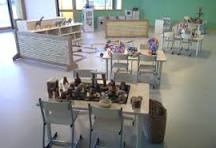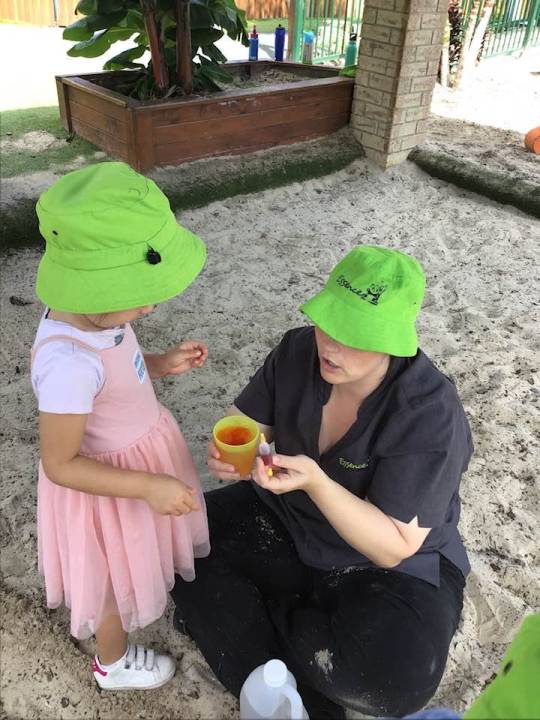#childcare centre
Text
Childcare Centre Fitout | Ultimate Chippy
Creating a welcoming and nurturing environment for children in a childcare centre requires careful consideration of design elements that cater to their needs and encourage growth and development. Here are some essential tips for a successful childcare centre fitout:

Safety as a Priority: Safety should always be the top priority when designing a childcare centre. Ensure that all furniture, fixtures, and equipment meet safety standards and regulations to minimize the risk of accidents. Consider features like rounded corners on furniture, non-slip flooring, and secure shelving to create a safe environment for children to explore.
Age-Appropriate Zones: Designate different areas within the childcare centre to accommodate the varying needs and developmental stages of children. Create separate zones for infants, toddlers, and preschoolers, each equipped with age-appropriate toys, activities, and furnishings. This allows children to engage in activities tailored to their interests and abilities.
Functional Layout: Optimize space and flow within the childcare centre by carefully planning the layout. Arrange furniture and play areas to create clear pathways and designated zones for different activities. Consider the flow of traffic and ensure that transitions between spaces are smooth and efficient to minimize congestion and maximize usability.
Comfort and Hygiene: Choose comfortable and easy-to-clean furnishings and materials to create a hygienic and inviting environment. Select durable, washable fabrics and surfaces that can withstand daily wear and tear. Provide ample storage solutions to keep toys, books, and supplies organized and accessible, promoting a clean and clutter-free space.
Stimulating Environments: Create stimulating and engaging environments that encourage exploration, creativity, and learning. Incorporate elements like colorful murals, interactive play areas, and sensory-rich materials to captivate children's imaginations and inspire curiosity. Outdoor play spaces with natural elements like sand pits, water features, and climbing structures offer opportunities for active play and connection with nature.
Collaboration and Feedback: Involve childcare staff, educators, and parents in the fitout process to ensure that the design meets the needs and preferences of all stakeholders. Seek input and feedback on layout, functionality, and educational resources to create a space that aligns with the centre's goals and values.
By following these tips, Childcare Centre Fitouts can create a nurturing and supportive environment where children can thrive and reach their full potential.

More Info Contact Us
Website https://www.ultimatechippy.com.au
Facebook urlhttps://www.facebook.com/ultimatechippy
Instagram urlhttps://www.instagram.com/
Address: Level 1, 1044A Dandenong Road, Carnegie, Victoria 3163
Ph: 03 9504 4036
Mail id: [email protected]
Working Time: Monday to Friday 9:00am – 5:00pm.
0 notes
Text
Childcare Redefined: Nurturing the Roots of Tomorrow's Forest
Introduction:
In the intricate tapestry of a child's growth, childcare serves as the nurturing soil from which mighty oaks of potential emerge. Yet, beyond the conventional notions of supervision and safety, modern childcare embodies a paradigm shift—a holistic approach that not only safeguards children but also cultivates the seeds of curiosity, resilience, and empathy. In this unique exploration, we delve into the essence of childcare, redefining it as a transformative journey that nurtures the roots of tomorrow's forest.

A Sanctuary of Safety and Belonging:
At its core, childcare provides a sanctuary—a haven where children feel safe, secure, and valued. Beyond the physical confines of walls and fences, childcare centers become nurturing environments where every child is welcomed with open arms and embraced as a cherished member of the community. Through attentive supervision, nurturing interactions, and a culture of inclusivity, childcare lays the foundation for a sense of belonging that becomes the fertile soil in which children's roots can firmly take hold.
Empowering Curiosity and Exploration:
In the garden of childcare, curiosity is the seed from which a forest of knowledge blossoms. Rather than stifling curiosity with rigid structures and predetermined outcomes, modern childcare embraces it as a driving force for exploration and discovery. Through open-ended play, hands-on experiences, and guided inquiry, children are encouraged to follow the winding paths of their interests, fostering a love for learning that transcends boundaries and ignites a lifelong pursuit of knowledge.
Cultivating Resilience and Adaptability:
In the ever-changing landscape of childhood, resilience becomes the sturdy trunk that weathers the storms of life's challenges. Through supportive relationships, positive reinforcement, and opportunities for self-expression, childcare nurtures the growth of resilience, empowering children to bounce back from setbacks, navigate obstacles, and embrace the inherent beauty of imperfection. As they learn to adapt and thrive in diverse environments, children emerge from childcare with roots that run deep and branches that reach for the sky.
Fostering Empathy and Connection:
In the forest of humanity, empathy is the network of roots that binds us all together in a web of interconnectedness. Through meaningful interactions, collaborative activities, and opportunities for reflection, childcare cultivates the seeds of empathy, nurturing children's capacity to understand, appreciate, and celebrate the differences that make each individual unique.
Conclusion:
In the symphony of childhood, childcare serves as the gentle melody that guides children along the winding paths of growth and discovery. Through its nurturing embrace, childcare redefines itself not merely as a place of supervision and safety but as a transformative journey that nurtures the roots of tomorrow's forest. By empowering curiosity, cultivating resilience, fostering empathy, and celebrating the inherent potential of every child, childcare becomes a beacon of hope—a sanctuary where the seeds of today blossom into the mighty trees of tomorrow.
0 notes
Text
Tools for Creative Learning – LittleGraces Childcare In NSW

When selecting tools for creative learning, it’s important to consider the age, interests, and developmental stage of the child. Providing a variety of materials allows children to explore different areas of interest and discover their passions. Encouraging open-ended play and experimentation fosters creativity, problem-solving skills, and a love for learning in children. For more information on how Childcare centre incorporate these activities in regular daycare activities visit https://www.littlegraces.com.au/rooms/
#childcare nsw#childcare near me#child care centre#daycare activities#childcare centre#childcare centres nsw#child care centres nsw#child care centre near me#best child care centres in sydney#best childcare centre in eastern creek#childcare in nsw#Childcare nsw#Childcare menu
0 notes
Text
Discovering Quality Childcare in Mackay: Tips and Insights
Introduction
Finding quality childcare is a top priority for parents, and in Mackay, where families thrive, the search for the perfect childcare centre is crucial. With a plethora of options available, it's essential to navigate the process wisely. This article provides valuable tips and insights to help parents discover top-notch childcare in Mackay.
Understanding Your Needs
Before diving into the search, take time to assess your family's specific needs and preferences. Consider factors such as location, hours of operation, cost, curriculum, and philosophy. Understanding what matters most to your family will streamline the selection process and ensure a better fit.
Researching Available Options
Begin your search by researching the childcare centres available in Mackay. Utilize online resources, such as directories and review websites, to gather information about each facility. Pay attention to reviews and ratings from other parents, but also schedule visits to get a firsthand impression.
Visiting Potential Centres
Schedule visits to the childcare centres that align with your criteria. During your visit, observe the cleanliness and safety measures in place. Take note of the staff-to-child ratio, the qualifications and demeanor of the caregivers, and the overall atmosphere of the centre. Don't hesitate to ask questions about the curriculum, daily routines, and communication with parents.
Checking Accreditation and Licensing
Ensure that the childcare centres you're considering are accredited and licensed by the relevant authorities. Accreditation indicates that a centre meets specific quality standards, while licensing ensures compliance with state regulations. This guarantees that your child will receive care in a safe and nurturing environment.
Engaging with the Community
Reach out to other parents in the Mackay community for recommendations and insights. Local parenting groups, online forums, and social media platforms can be valuable resources for gathering information and connecting with other families who have firsthand experience with childcare centres in the area.
Trust Your Instincts
Ultimately, trust your instincts when making a decision about childcare. Pay attention to how you feel during your visits and interactions with staff members. Your intuition can be a powerful guide in determining whether a childcare centre is the right fit for your child and your family.
Conclusion
Finding quality childcare in Mackay requires careful consideration and research. By understanding your needs, researching available options, visiting potential centres, checking accreditation, engaging with the community, and trusting your instincts, you can discover a childcare centre that provides a safe, nurturing, and enriching environment for your child. With these tips and insights, you can embark on your search with confidence and peace of mind.
1 note
·
View note
Text
Summer Break Camp in Chilliwack

Adventure awaits at Fraser River CEC's Summer Break Camp in Chilliwack! ☀️ Join us for a summer of fun, learning, and unforgettable memories along the banks of the Fraser River. From outdoor activities to arts and crafts, there's something for every young explorer. Enroll today and let the summer magic begin! 🏕️
#FraserRiverCEC#SummerCamp#ChilliwackAdventures#summer camp#summer break camp#child care program#childcare centre in chilliwack#best after school care program in chilliwack#child care facilities#childcare centre#best day care chilliwack
0 notes
Text
Benefits of an Early Learning Childcare Centre
An early learning childcare centre offers children a safe and nurturing environment. It also provides educational opportunities. However, it can be more expensive than a regular daycare center.

The building design should take into consideration the needs of parents as well as children. This may include a convenient and welcoming entry, private places to meet with staff, and storage for car seats and strollers.
Socialization
Children who have strong social skills tend to have better academic performance than their peers. This is because having a healthy social life helps them connect with instructors and peers alike, which improves their overall experience at school.
A quality early learning centre offers the right balance of structure and freedom for young kids to learn and play together. It provides a safe environment for children to express their feelings, learn to interact with people of all ages, and solve conflicts.
Aside from helping them learn how to communicate with others, early learning childcare centre also teach kids about their personalities and characteristics. This allows them to build a sense of self-confidence that will help them succeed in their future endeavors. This will also enable them to become more resilient in the face of challenges.
Language Development
Children develop language by learning and absorbing the words and sounds around them. They also learn to interact with others in a social context. In addition to playing and talking with their peers, they may be encouraged to use art and other sensory experiences to help them express themselves.
When working with children, it’s important to speak in a clear, concise manner, make eye contact and be willing to get down to their level if necessary. It’s also important to give them lots of turn-taking in conversations to stimulate their language centres.
Oral language development can also be supported through the use of picture books and through the promotion of daily care routines such as nappy changing and hand washing. This will encourage communication between teachers and children.
Physical Development
Children who experience quality early learning have better academic achievements and have higher self-esteem than kids who don’t receive this kind of education. They are also less likely to get into trouble or have behavioral issues in their teen years.
Physical development activities offered at an early learning centre help little ones improve their gross motor skills by playing games such as obstacle courses or limbo.
These activities can also encourage babies to spend more time on their tummies, which is vital for their overall health and development.
Parents with hectic schedules can benefit from the flexibility that early learning centres offer, especially when it comes to after-hours care or long daycare. They are similar to day care centres but place more emphasis on educational opportunities.
Cognitive Development
Kids in quality early learning programs are more likely to reach academic and developmental milestones. They also tend to have better life outcomes in adulthood.
Infants' cognitive development is a vital part of their growth. It isn't just about babbling and responding to their names; it's how they explore and learn through their senses and motor movements.
Jean Piaget has broken down cognitive development into four distinct stages. These include the sensorimotor stage, which lasts until about age two, and the preoperational stage.
At this stage, toddlers and preschoolers begin to form symbolic thinking and can take on the role of other people. Teachers at early learning centres help children develop their logic by offering thought-provoking activities and games. For example, they may ask toddlers to play "what does this look like?" and encourage them to think about the answer.
Preparation for Kindergarten
Children are better prepared to learn reading and writing skills when they enter kindergarten with a large vocabulary. They also have a firm grasp of the sounds that different letters make, and have been introduced to basic concepts like number, shape, direction, and ordering.
An early learning center focuses on all areas of development and prepares children for kindergarten and beyond. It is a safe and healthy environment with trained educators who nurture a child’s natural curiosity.
Once you have established your curriculum, team, and facility, it’s time to get the word out! Let the local community know about your new early learning childcare centre, and spread the word through your online presence, social media, directories, and open house events. With the right tools, you can grow your early learning center into a successful educational institution.
0 notes
Text

Fun ‘n’ Play Childcare Centre is a privately owned, offering a nurturing home like environment for children from 2 to 6 years. The Management and Educators of Fun ‘n’ Play childcare centre aim to provide high quality care and education for young children. Children deserve the best and we strive to provide this by employing trained and nurturing teachers.
Within the Centre programme we incorporate the principles, Strands and Goals of Te Whariki– The NZ Early Childhood Curriculum, which reflects the holistic way that children learn and grow.
0 notes
Text

"Need Child Care Centres," Windsor Star. June 21, 1943. Page 14.
----
For Youngsters 6-15 Years, as Well as for Tots
----
By GARRY C. MYERS, PhD.
A number of the large war-production areas are establishing child-caring centres for the small children of working mothers. But there are almost no such centres for children from six to15.
Even if enough such protective centres for working mothers' children from six to 15 were available, not many of these children would be in them.
During the long summer months thousands of children will be roaming the streets without guidance or protection. It was bad enough for these children when they were in school part of the day. It is much worse during the long summer vacation.
A DOUBLE DAY'S WORK
The mother while at work, if she really cares, must be anxious for the physical and moral safety of her neglected children. Coming home weary, she must not only face another day's work about the house, but often also face the reported difficulties her child got into during her absence. These problems mount and multiply as time goes on. Under the most favorable conditions, it is hard to deal with the child who is reported to have done some wrong while the parent was away. It is much more difficult when this parent is absent day after day for weeks and months on end.
There can be no ideal solution, of course, except for the mother to stop work and remain home to look after her child or she could get a competent substitute or place him in a child-protecting centre. Neither of these can be so good for the child as the best mother can be. Moreover, the average mother who works may not be able to make sure her child. especially between 10 and 14, would always be in the centre when he is supposed to be there.
OFFERS AID BULLETIN
Nevertheless, in an effort to offer sympathetic help to the working mother for dealing as well with her child as possible, I have prepared a special bulletin on "Suggestions for Working Mothers," to be had for post- age by writing me in care of this paper.
SOLVING PARENT PROBLEMS
Q. I have been reading to my three-year-old daughter since she was 16 months of age, but she won't say the rhymes and stories for me, especially when guests are present.
A. Don't ask her to say them. Just keep filling her up by reading and reading to her and by and by she will respond. Better still, she may make up rhymes or yarns of her own. By all means, don't have your child show off before your guests. My selected list of books from which to read to the baby and young child may be had without cost to you, by writing me in care of this paper.
#advice column#child care#childcare centre#daycare#birth of the welfare state#working mothers#history of daycare#summer vacation#children in canadian history#canada during world war 2
0 notes
Text
The Benefits of a Childcare Centre
A childcare centre provides full or part-time care for infants, toddlers, pre-schoolers and school-age children ranging from infants and toddlers through pre-schoolers and school-age children. Furthermore, these centres may also offer weekend and holiday care.
Childcare centres must meet various state licensing or certification requirements to be eligible to operate in their states. In addition, specific legislation outlines requirements such as physical facilities (washroom, eating areas, sleeping arrangements and lighting levels), staff qualifications, and more.
Educational Programs
Childcare allows your children to develop meaningful life and social skills, including literacy and numeracy skills in pre-schoolers and life, self-help and social abilities in school-age children.
Staff at childcare centres are highly-trained educators with experience working with children, so they are equipped to create educational and entertaining programs. In addition, programs explicitly tailored to your child's interests help them realise their full potential in all areas of development.
Early childhood education and care programs include numerous different kinds of early education and care services for infants and toddlers. This can range from preschools (kindergartens, pre-kindergartens, compensatory education programs and nursery schools that operate under educational auspices) to child care centres and family child care homes.
Child Care
A childcare centre provides children with an environment to learn and grow. It can be located anywhere - including homes, schools or businesses.
Childcare centres provide essential education and care to infants, toddlers and pre-schoolers. You'll find these centres located throughout the country regulated by state governments.
The ideal childcare providers possess the education and training to help children flourish and learn, in addition to being licensed.
Two primary types of childcare centres are family child care homes and child care centres.
Family childcare homes provide residential settings where members or couples care for children from within their own family or another. Such settings can be an excellent option for working parents who prefer having their children nearby.
Childcare centres are more extensive facilities that run out of non-residential buildings and are typically staffed with a director or team of teachers, often grouping children according to age and enrolling more children than family child care homes.
Parenting Classes
Parenting classes offer an invaluable way to gain advice and skills from experienced parents when dealing with children. Attending one can help you manage situations more effectively while decreasing stress levels associated with parenting children.
Parenting education programs may be available through your local childcare centre, community centre, library and county extension office. Some offer in-person training, while others may provide online options.
Attending a parenting class has many advantages, including meeting other parents and sharing your concerns and worries with them. Such relationships can lead to positive results for your child and you as their parent.
Studies have demonstrated the value of parenting education to improve parent-child relationships and curb challenging behaviour among children while building confidence among parents.
Transportation
One of the most significant challenges child care centres faces is transporting children safely to and from various activities, be they trips to the zoo, park visits or dentist appointments. Finding an efficient and safe means of getting children from one activity to the next is vital; various companies specialise in keeping little ones happy and healthy; using one of their services will speed up your day and reduce stress significantly.
At their core, quality childcare centre services don't have to be sacrificed in favour of saving money. For instance, an efficient way of transporting children between locations is hiring a shuttle service that offers affordable and dependable shuttle service, taking your children directly to where they need to be on your behalf.
1 note
·
View note
Text
The Psychology of Interior Design: How Companies in Various Industries Use Design to Influence Consumer Behavior and Emotions
Interior design is a powerful tool that businesses use to create an atmosphere that encourages consumers to feel and behave in certain ways. Whether it's in a retail store, restaurant, hotel, hospital, or an office space, interior design can influence the mood, emotions, and behaviors of the people who inhabit those spaces. We'll explore the psychology of interior design and how companies in various industries use it to their advantage. We'll also examine the unique challenges and opportunities of designing interior spaces for childcare centers.
The Role of Color, Lighting, and Layout in Creating Different Moods and Atmosphere
One of the most obvious ways that interior design influences people's emotions is through color, lighting, and layout. Colors, in particular, have a powerful effect on our mood and behavior. For example, warm colors like red, orange, and yellow are associated with excitement, energy, and passion, while cool colors like blue, green, and purple are associated with calmness, relaxation, and focus. Companies focusing on interior design across multiple industries use color in various ways to create the desired mood and atmosphere for their customers.
Similarly, lighting can also affect how people feel in a space. Bright, intense lighting is typically associated with productivity and energy, while soft, warm lighting is associated with relaxation and comfort. Companies in the hospitality industry, for example, may use dimmer lighting to create a more romantic atmosphere for couples, while retail stores may use brighter lighting to highlight their products and encourage sales.
Finally, the layout of a space can also influence people's emotions and behavior. Open, spacious layouts can create a sense of freedom and creativity, while enclosed, cozy spaces can create a sense of intimacy and security. Companies in the office design industry, for example, may use open layouts to encourage collaboration and innovation, while hospitals may use enclosed spaces to provide a sense of privacy and comfort for patients.
The Use of Sensory Design to Enhance the User Experience
Another way that interior design can influence people's emotions is through sensory design. Sensory design refers to the use of textures, scents, sounds, and other sensory elements to enhance the user experience in a space. For example, a hotel may use the scent of lavender in their lobby to create a calming atmosphere, while a restaurant may play soft jazz music to create a romantic ambiance.
In the retail industry, sensory design is used to create a multisensory shopping experience that engages customers on multiple levels. Retailers may use unique textures and materials to create a tactile experience, while also using music, lighting, and scents to create a cohesive brand experience.
The Influence of Cultural and Demographic Factors on Interior Design Preferences and Expectations
Interior design preferences and expectations can also be influenced by cultural and demographic factors. For example, people in different cultures may have different expectations for the layout, lighting, and color schemes of a restaurant or hotel. Similarly, people in different age groups may have different preferences for the style and function of an office or retail space.
Companies must take these cultural and demographic factors into account when designing their interior spaces. This may involve conducting market research to better understand the preferences and expectations of their target audience, as well as adapting their designs to meet the needs of different cultural groups.
The Ethical Implications of Using Design to Manipulate Consumer Behavior
While interior design can be a powerful tool for creating a positive user experience, it can also be used to manipulate consumer behavior in unethical ways. For example, retailers may use lighting, music, and other sensory elements to create a sense of urgency and encourage impulse purchases. Similarly, some restaurants may use certain color schemes and lighting to make food appear more appetizing than it actually is.
These practices raise ethical concerns about the use of interior design to manipulate consumer behavior. Companies must balance their desire to create a positive user experience with their responsibility to respect the autonomy and well-being of their customers. This may involve adopting a more transparent and ethical approach to interior design, such as clearly labeling promotional items and avoiding deceptive practices.
The Challenges and Opportunities of Designing Spaces for Children's Unique Needs and Developmental Stages
Finally, designing interior spaces for childcare centers presents unique challenges and opportunities. Children have unique needs and developmental stages that must be taken into account when designing spaces for them. For example, younger children may need more open, safe spaces to explore, while older children may need more private spaces for quiet activities or homework.
Childcare centers must also consider the safety and functionality of their interior spaces, such as choosing materials that are durable and easy to clean, and designing spaces that promote safety and supervision.
However, designing interior spaces for children also presents opportunities to stimulate their creativity and imagination. Childcare centers may use bright colors, fun patterns, and playful elements to create a stimulating and engaging environment for children to learn and play.
Interior design plays a crucial role in shaping people's experiences and behaviors in different settings. Companies in various industries use interior design to create a positive user experience, influence consumer behavior, and meet the unique needs and preferences of their target audience. However, they must also consider the ethical implications of using design to manipulate consumer behavior and take a responsible and transparent approach to interior design. Ultimately, the goal of interior design should be to create spaces that promote well-being, comfort, and happiness for all who inhabit them.
Read Also
Russian Hackers Target Airport In Germany
Dutch Lady To Discontinue Milk Powder Production
Over 40,000 Banned In Dota 2 Latest Ban Wave
Unsure How To Plan A Successful Restaurant Renovation? Check This Out!
Go Green In 3 Simple Steps For Your Eco-Friendly Classroom
#interior design#kitchen interior design#interior decor inspiration#childcare centre#singapore#interior decor ideas#decor#interior specialist
0 notes
Text
Guiding Little Stars: The Heart of Childcare Centers

Childcare centers serve as essential pillars of support for families, offering a nurturing and educational environment for young children. These centers provide a safe and secure space where children can learn, grow, and explore under the guidance of qualified educators. Key features of childcare centers include age-appropriate curriculum, stimulating activities, and personalized care that caters to the unique needs of each child. Through play-based learning, social interactions, and structured routines, childcare centers foster the development of essential skills such as communication, problem-solving, and emotional regulation. Additionally, they often prioritize building strong partnerships with families, encouraging open communication and collaboration to ensure the holistic well-being of every child. In essence, childcare centers play a crucial role in laying the foundation for children's future success by providing a supportive and enriching environment where they can flourish.
For more information please contact us-
1 note
·
View note
Text
Key Socialization Skills That Children Typically Develop In a Child Care Centre -

In a Childcare Centre setting, children typically develop a range of socialization skills that are crucial for their overall growth and interaction with others. Here are key socialization skills often fostered in Childcare Centre:
1. Sharing and Taking Turns: - Learning to share toys, materials, and attention, as well as taking turns in various activities.
2. Cooperation and Teamwork: - Engaging in group activities and projects, fostering a sense of cooperation and teamwork.
3. Communication Skills: - Developing verbal and non-verbal communication skills, expressing needs, and listening to others.
4. Conflict Resolution: - Learning to resolve conflicts peacefully, express feelings, and negotiate with peers.
5. Empathy and Understanding: - Cultivating empathy by understanding and recognizing the feelings of others.
6. Independence and Self-Regulation: - Building independence in tasks like dressing and organizing belongings, as well as developing self-regulation skills.
7. Respecting Differences: - Appreciating and respecting differences in backgrounds, abilities, and interests among classmates.
8. Following Rules and Routines: - Understanding and following classroom rules and routines, promoting a structured environment.
9. Problem-Solving: - Developing problem-solving skills through various activities and challenges.
10. Initiating and Maintaining Friendships: - Learning how to approach others, make friends, and maintain positive relationships.
11. Responsibility: - Taking on simple responsibilities, such as cleaning up after activities or caring for classroom materials.
12. Listening Skills: - Enhancing active listening skills during group discussions, storytime, and instructions.
Childcare centre like LittleGraces Childcare in nsw provides a crucial social environment where children interact with peers and adults, laying the foundation for future social skills and emotional intelligence. These skills are not only important for academic success but also contribute to the child’s overall well-being and ability to navigate social situations throughout life. For more information on daycare activities and Parenting resources you can visit https://www.littlegraces.com.au/resources/
#childcare nsw#child care centres nsw#childcare near me#childcare centres nsw#daycare activities#child care centre#childcare centre#best childcare centre in eastern creek#best child care centres in sydney#child care centre near me#childcare centre nsw#childcare menu ideas#Childcare menu
0 notes
Text
Summer Break Camp Chilliwack: A Parent’s Survival Guide

Introduction:
As the school year winds down and summer break approaches, many parents find themselves in search of engaging and enriching activities to keep their children occupied. For families in the Chilliwack area, the Fraser River Community Education Centre (CEC) offers an exciting Summer Break Camp that promises fun-filled days and memorable experiences for children of all ages. In this survival guide, we’ll explore what makes the Summer Break Camp in Chilliwack a must-consider option for parents and how to make the most of this opportunity. Read More.
#summer camp#summer break camp#summer camp program#childcare centre in chilliwack#childcare centre#child care program#child care facilities#best after school care program in chilliwack#infant day care
0 notes
Text
The Benefits of an Early Learning Childcare Centre
Researchers have found that high-quality early learning can have long-term benefits, including narrowing the achievement gap. It also provides a warm and supportive environment that fosters children’s curiosity and love for learning.
Unlike daycare, an early learning childcare centre offers more educational opportunities. It serves children 6 weeks through Kindergarten, and often provides after school care as well.
Educational programs
An early learning centre is a child care facility that offers educational opportunities. It’s a great choice for parents who value the importance of learning in their children’s lives. A quality early learning center will give your child the tools they need to succeed in the next phase of their life.

A traditional childcare centre is a place where working parents send their children to be watched while they are away from home. These centres typically offer basic care, such as meals and supervision. While they may also offer some educational activities, they are not designed to promote learning and development.
The New York City Department of Education provides affordable early childhood programs for families with children birth to five years old, including preschool and EarlyLearn. Some programs are located in child-care centers, while others are offered through family child care networks. Some of these programs are available in both a child-care center setting and in residences.
Routines
A carefully crafted routine serves as a guiding force for children and caregivers. It syncs with their internal clocks and offers a sense of safety and security. In addition, it helps children cope with transitions and self-control.
Young children are also socially shaped through the interactions they have with other people. This happens through routines such as greetings and good-byes, sharing toys, playing games, and eating meals. These interactions allow children to learn social skills that will serve them throughout their life.
It is important to have a balance between small group activities and free choice time for each day of the week. It is also helpful to incorporate a variety of different educational programs into the daily schedule. This will help keep children engaged in their learning and prevent boredom. Also, it is a good idea to select music that encourages movement and provides clear instructions (like the 10 steps of the Wiggles or Shake Your Sillies Out). This will help children stay engaged without distraction.
Social-emotional development
Social-emotional development and learning is a critical component of a child’s success. It helps children learn to manage their emotions and build relationships, which are essential for healthy development and learning. Caregivers play an important role in promoting social-emotional development. By providing nurturing relationships, they help children develop the neural connections necessary for executive function skills.
In family childcare settings, social-emotional development often happens organically as teachers and children interact. However, it can also be taught and nurtured. The following resources provide ideas for integrating and embedding social-emotional learning opportunities into daily experiences and routines.
Encourage children to express their feelings and interact with others in a safe, positive environment. Provide support for children who are having difficulty expressing their feelings or engaging in social interactions by guiding them with activities that promote emotional literacy and self-regulation. Also, reinforce positive behaviors with praise and other forms of reinforcement. This will help children feel confident and safe in their environment.
Creative arts
An early learning childcare centre offers children a wide range of educational opportunities. Its curriculum covers all developmental domains, and its teachers are experienced in encouraging children to be self-advocates. It also focuses on socialemotional development, which is critical for cognitive growth and success.
Creative arts activities help young children cultivate their imaginations and abilities across every domain. They are open-ended and foster divergent thinking, which teaches kids that the process is often more important than the product. They are also essential for building creativity and self-esteem.
The visual arts environment and materials you offer communicate to students, families, and your teaching team how much you value artistic expression in the classroom. Rich visual arts experiences don’t have to cost a lot of money. For example, natural materials can be thoughtfully collected for ephemeral art and recycled materials can be arranged aesthetically to create three-dimensional sculptures. These experiences provide children with a sense of wonder and exploration and help them build fine and gross motor skills.
0 notes
Text
Are you looking for child care center in Auckland? Fun ‘n’ Play auckland daycare care provides more information on education for baby daycares and preschoolers."
0 notes